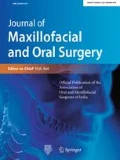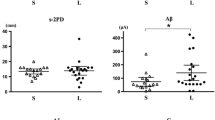Abstract
Aim and Objectives
The prospective study was to evaluate the incidence, type of neurosensory disturbance (NSD), grade its severity and monitor its recovery occurring in the lower lip and chin due to damage to inferior alveolar nerve following orthognathic surgery involving mandible.
Materials and Methods
The study included 10 patients who have undergone sagittal split osteotomy, genioplasty, and anterior subapical osteotomy (ASO). All the patients examined preoperatively and post operatively 1 week, 1 and 6 months according to standardized test to clarify the subjective and objective neurosensory status of the injured nerve. Pin prick test, blunt test, two-point discrimator test, brush stoke direction, light touch test, warm and cold test were used bilaterally to lower lip and chin area.
Results
Seven patients underwent bilateral sagittal split osteotomy (BSSO) (70 %), one patient had BSSO with genioplasty (10 %), two patients had BSSO with ASO (20 %). During the operation none of the nerves were transectioned, in 60 % of patients nerve was not visible and in 40 % of patients nerve was seen in distal segment. 70 % of patients underwent setback, 30 % of patients underwent advancement. The subjective evaluation of the patients revealed the incidence of 90 % at 1 week, 30 % at 1 month, 20 % at 6 months and 10 % at 1 year post operatively. The altered sensation reported subjectively was hypoesthesia in 50 % of the patients, anaesthesia in 40 % of the patients. There was 100 % recovery in advancement cases and 93.5 % recovery in setback cases.
Conclusion
There is a high incidence of NSD of the lower lip and chin after BSSO related to advancement, setback, intraoperative nerve encounter and surgical skill. However, recovery of sensation occurs with increasing frequency during the follow-up period. The clinical neurosensory tests are effective guides to study the neurosensory deficit.








Similar content being viewed by others
References
Pratt CA, Tippett H, Barnard JDW, Birnie DJ (1996) Labial sensory function following sagittal split osteotomy. Br J Of Oral Maxillofacial Surgery 34:75–81
Poort LJ, van Neck JW (2009) Sensory testing of inferior alveolar nerve injuries: a review of methods used in prospective studies. J Oral Maxillofac Surg 67:292–300
Steel BJ, Cope MR (2012) Unusual and rare complications of orthognathic surgery: a literature review. J Oral Maxillofac Surg 70:1678–1691
Van Merkesteyn JPR, Zweers A, Corputty JEM (2007) Neurosensory disturbances one year after bilateral sagittal split mandibular ramus osteotomy performed with separators. J Cranio-Maxillofac Surg 35:222–226
Mouro M, Ghali E, Lahen EP, Waite DP et al (2004) Peterson’s principles of oral & maxillofacial surgery, 2nd edn. BC Decker Inc. Hamilton, London
Fonseca (2009) Textbook oral and maxillofacial surgery, vol 3, 2nd edn. W.B Saunders Company, Philadelphia, Pennsylvania
Cmpbell RL, Shamaskin RG, Harkins SW (1987) Assessment of recovery from injury to inferior alveolar and mental nerves. Oral Surg Oral Med Oral Pathol 64:519–526
Nishioka GJ, Zysset MK, Van Sickels JE (1987) Neurosensory disturbance with rigid fixation of the bilateral sagittal split osteotomy. J Oral Maxillofac Surg 45:20–26
MacIntosh RB (1981) Experience with the sagittal osteotomy of the mandibular ramus: a 13 year review. J Oral Maxillofac Surg 8:151–165
Yamauchi K, Takahashi T, Kaneuji T, Nogami S, Yamamoto N, Miyamoto I, Yamashita Y (2012) Risk factors for neurosensory disturbance after bilateral sagittal split osteotomy based on position of mandibular canal and morphology of mandibular angle. J Oral Maxillofac Surg 70:401–406
Westermark A, Bystedt H, von Konow L (1998) Inferior alveolar nerve function after sagittal split osteotomy of the mandible: correlation with degree of intraoperative nerve encounter and other variables in 496 operations. Br J Oral Maxillofac Surg 36:429–433
Westermark A, Bystedt H, Von Konow L (1998) Inferior alveolar nerve function after mandibular osteotomies. Br J Oral Maxillofac Surg 36:425–428
Posnick JC, Al-Quattan MM, Stepner NM (1996) Alteration in facial sensibility in adolescents following sagittal split and chin osteotomies of the mandible. Plast Reconstr Surg 97:920–927
Lindquist CC, Obeid G (1988) Complications of genioplasty done alone or in combination with sagittal split-ramus osteotomy. Oral Surg Oral Med Oral Pathol 66:13–16
Conflict of interest
None declared.
Author information
Authors and Affiliations
Corresponding author
Rights and permissions
About this article
Cite this article
Degala, S., Shetty, S.K. & Bhanumathi, M. Evaluation of Neurosensory Disturbance Following Orthognathic Surgery: A Prospective Study. J. Maxillofac. Oral Surg. 14, 24–31 (2015). https://doi.org/10.1007/s12663-013-0577-5
Received:
Accepted:
Published:
Issue Date:
DOI: https://doi.org/10.1007/s12663-013-0577-5




